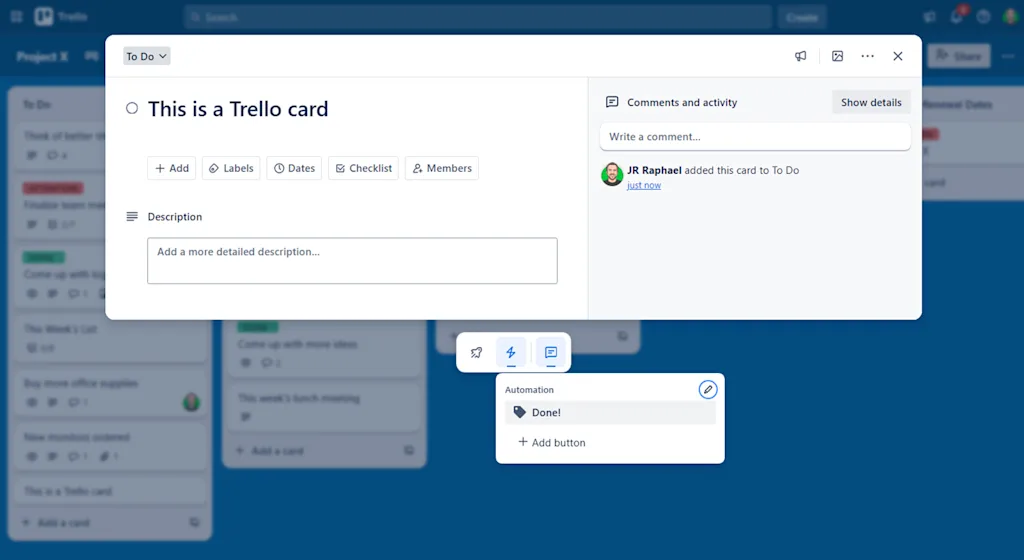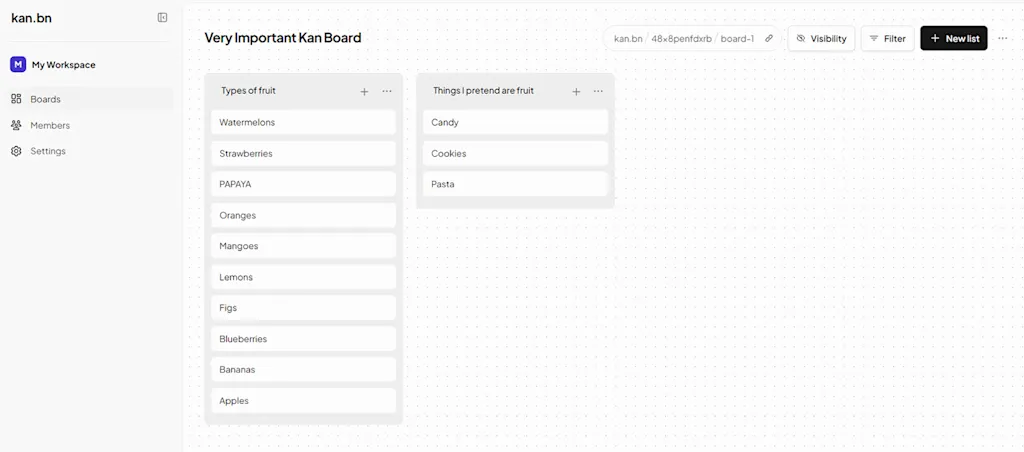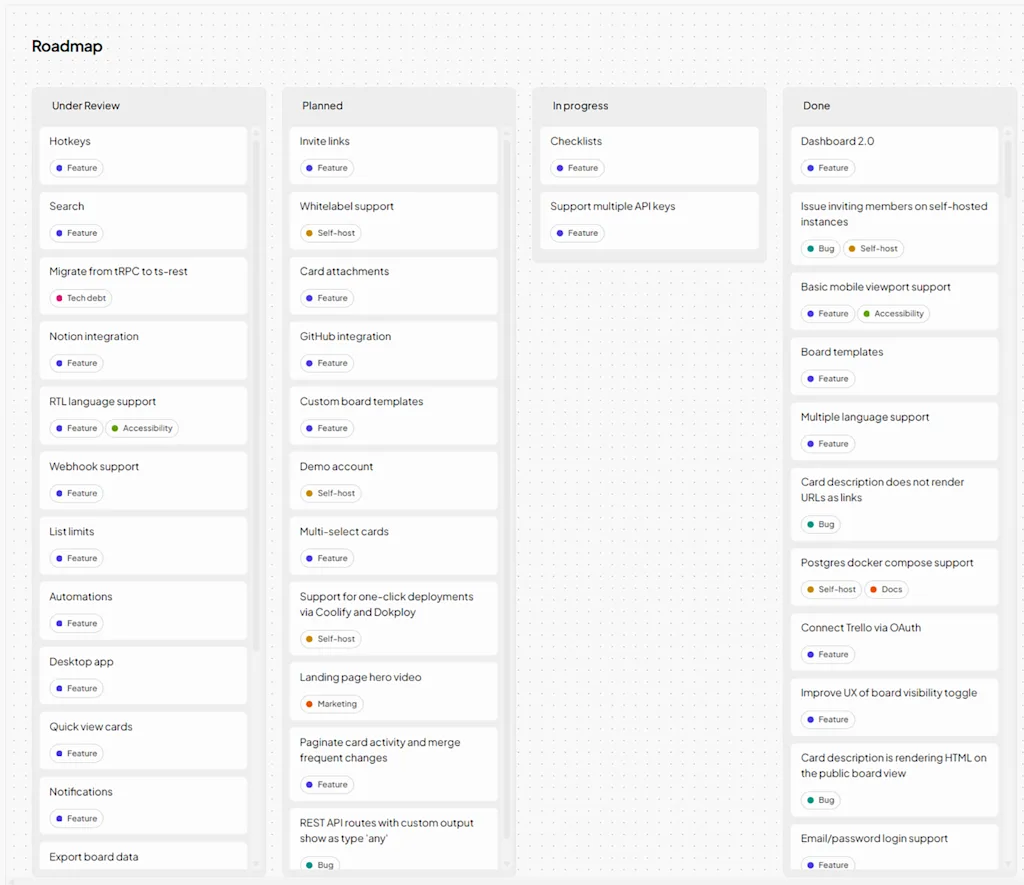For all the many features it’s been lobbing into the world lately, Trello hasn’t given its most dedicated fans the one thing many of them crave most—and that’s a ticket back in time to the app’s original vision.
In an era where most software is in a near-constant state of evolution, the very idea of turning back the clock may sound crazy. But plenty of folks think Trello—the multipurpose organization tool owned by Atlassian since 2014—has lost its focus on the streamlined approachability that once made it worth using.
An engineer from England is hoping to fix that. He’s built a robust reimagining of the original Trello concept as a fully open-source service. His goal is to offer a way for any like-minded Trello enthusiasts—or anyone who might appreciate what Trello used to represent—a simple, frills-free, productive experience more in line with the Trello of a decade ago.
If you’re reading this with wide eyes and an involuntary nodding of your head (or at least the sensation of such nodding, with or without the physical movement), his creation might be just the answer you’ve been coveting.
And even if you aren’t, you might be intrigued by the pure simplicity of a productivity tool that’s trying only to do one thing—and do it exceptionally well.
Trello, reimagined—and reinvented
Let’s get one thing out of the way first: Henry Griffiths-Ball probably isn’t a name you’ve heard before. He isn’t one of the famed Silicon Valley startup kings who lives to launch a sizzling new company every few years, nor is he a former employee at Google, Apple, or any of the other places most of the flashier founders seem to come from.
He is, however, a soft-spoken, regular-seeming guy who really loves Trello—or at least really loved what Trello once represented. And he’s determined to re-create that old vision for other people who feel the same way, then see where it goes from there.
Griffiths-Ball has been using his spare time over the past several months to flesh out something he calls Kan.bn—or just Kan for short. Using the service really does feel like stepping into a time capsule and getting back to what once made Trello so special, before it went through the kind of identity crisis that seems to plague so many services sooner or later. And you don’t necessarily have to be a Trello fanatic to appreciate it.
But the history of Trello’s evolution is a critical part of Kan’s story. Way back in the prehistoric era of 2011, you see, a developer named Joel Spolsky showed off a show-stealing app he’d built as part of a conference called TechCrunch Disrupt. At the time, it was unlike anything else out there—and it immediately won over throngs of devoted users as a result of its frills-free organizational philosophy.
That service, as you may have surmised, was none other than Trello. As TechCrunch’s Leena Rao summed up at the time:
The web-based application is designed to be the centralized place where all collaborative team work can be assigned and tracked. The startup says that other project management systems are developer-focused, too complex, and don’t appeal to a broader community. Trello has been built for any type of workflow, from being a business-focused tool to even acting as [a] personal list-management application.
Even in that earliest form, Trello’s calling card was its simplicity. The service revolved around a then-unusual board-based interface—what’s now commonly known as a kanban-style setup—to make it easy to organize anything into lists of column-based cards.
Everyone from engineers to product managers and even lowly journalists eagerly embraced Trello and turned it into their all-purpose organizational epicenter for projects both professional and personal.
“it just had this kind of magic,” Griffiths-Ball remembers. “They did something that was so simple but so effective.”
In 2014, Trello was acquired by software behemoth Atlassian for a cool $425 million. And that moment, in the eyes of superfans like Griffiths-Ball, is when everything started to change.
Whether that’s a positive or a negative is of course in the eye of the beholder, but as someone who’s both used and written about Trello for years now, the app’s evolution is impossible to ignore. At times, it’s struck me as a positive, even exciting progression—such as when Trello added a powerful automation system into its software back in 2019, opening up the door to all sorts of interesting new possibilities. Other updates seemed notably less in line with the original vision, such as 2021’s move to add alternate views into the mix alongside the signature Trello boards—with the aim of turning Trello into a more versatile all-purpose productivity supertool like Airtable or Notion.
That move—along with the ability to embed things like Google Docs documents directly into Trello cards—faded away over time, suggesting that it wasn’t exactly eagerly embraced. But the notion of transforming Trello into something more substantial continued, most recently with this year’s full-fledged repositioning of the service as a personal tasks app.
When I first wrote about that change back in February, I felt cautiously optimistic that it wouldn’t be overly disruptive for long-standing Trello fans like myself. Heck, the Atlassian executive I interviewed outright told me the service would continue to support “legacy” use cases, in spite of the newfound focus on task management. And, to his credit, it does.
The issue is with the final form that evolution adopted. Unlike the early version I saw while working on that article, it buried features that were once front and center and made them cumbersome to access. It was a relatively subtle shift on the surface, but all those extra clicks and all the extra hunting for formerly prominent options made an immediately noticeable difference in how the app felt to use. You can certainly still rely on Trello for any manner of project management, but it feels like you’re jumping through hoops to do so and using a service in a way it’s no longer designed to handle.
Plain and simple, it’s no longer plain and simple. And it’s hard not to wonder how long it’ll be until at least some of those now-legacy use cases fade even further from the foreground.

I’m far from the only one who’s noticed. A Reddit forum dedicated to Trello is filled with pages upon pages of discussions from frustrated Trello customers venting about the changes, begging for a way to undo them, and asking for recommendations about services to seek out as replacements.
It’s the feeling Griffiths-Ball has been struggling with for a while now. So he started looking around to see if anyone had built anything to address the lingering demand for the simple board-based organization concept Trello created and eventually abandoned as a primary focus.
“I always had in my head this idea of something like Trello but with a more modern twist and modern design practices,” he says. “I thought I’d take a stab at it and see if I can make something that fits my needs—then share it and see if anyone else is excited about the idea.”
And that’s precisely how Kan was born.
Back to square one—and beyond
The interesting thing about signing into Kan for the first time is that it feels new and electrifying—and yet simultaneously quite familiar, especially if you’ve spent any time in Trello over the years.
But it truly is an updated take on Trello’s original form, at least as a starting point. And especially as someone who connected more with Trello’s original vision and mostly just tolerated the more recent pivots and additions, it’s a bit of a revelation to use.
At its core, Kan gives you a super-minimalist and frills-free Trello-style Kanban board—a framework for creating any kind of cards and then dragging and dropping ’em across multiple lists in as many boards as you want. And the extent to which Griffiths-Ball has been able to build upon the original Trello vision is staggering.

For now, it feels like a trade-off of sorts: On the one hand, the experience is—not surprisingly—noticeably less polished and more barebones than what Atlassian presently offers. But on the other, it’s so delightfully refreshing to use a version of the core Trello concept without all the bloat and unfocused compromises that have built up over the years, particularly from those most recent Trello changes.
The critical context to keep in mind is that Kan is only a couple of months old and still the result of a single person’s primary effort. Although an interesting asterisk does exist: Griffiths-Ball is committed to building Kan as a completely open-source project, and already, he’s had about a dozen other people contributing on some level to the service.
“I’m getting messages from people every day,” he says. “That’s the beauty of open source: You put something out there, and you get immediate feedback from everybody—not just on the product but on the code, the features. That’s something you just don’t get with proprietary stuff.”
As part of that open source promise, anyone can view Kan’s underlying code on GitHub and, with the right level of technical prowess, see for themselves exactly what the service is and isn’t doing. And beyond that, anyone with the right knowledge can also take the code and host it entirely on their own cloud storage—even (at least in theory) forking and modifying the software to suit their own personal needs.
“Especially in the open-source community, people want products but also want the ability to own their data,” Griffiths-Ball says. “That, to me, is really exciting.”
That self-hosting option will always remain both free and freely available, Griffiths-Ball promises—as will the ability for individual users to rely on a fully featured hosted version of the service, without any limitations on core capabilities. Where Griffiths-Ball hopes to make money and make Kan sustainable is with the service’s team plans, where he’ll charge $8 per user per month for a managed setup starting this month.
But that’s all for down the road. For now, Griffiths-Ball’s main goal is to keep charging forward toward reaching full feature parity with the conventional Trello concept. High up on his road map (which, naturally, exists as a public Kan board) are items such as search, keyboard hotkeys, notifications, automations, and native desktop and mobile apps (though, as Griffiths-Ball notes, the website works quite well in all contexts for the time being, so there’s really no huge rush to move past that).

For many productivity app dwellers—myself included—it won’t be possible to trade Trello for Kan until at least some of those more ambitious elements are addressed. But the foundation is already enough to be promising. And, with Griffiths-Ball confident he’ll reach that all-important point of primary feature parity soon, it’s the next phase that’s truly alluring.
Griffiths-Ball, you see, isn’t content simply re-creating what was lost in Trello’s past. To him, that’s merely phase one—and what comes next is largely dependent on the people using his product, particularly with what he’s seen happen to Trello and so many other popular services from the perspective of their original users over time.
“I don’t want to make something that nobody asks for,” he says. “I want [the service’s road map] to be led by the users—to know how it’s being used and to make things that actually solve specific problems for those same people.”
One early idea is creating a Sunsama-like planner feature that’d bring more useful calendar functions into the Kan environment. But more than anything, the goal is about avoiding what Griffiths-Ball sees as Trello’s failure—and that’s focusing on the business first and the vision second.
“What’s important to me is usability. I want to hear how people are using Kan and I want to know how we can make it better for people.”
Be the first to find all sorts of fascinating productivity apps with my free Cool Tools newsletter from The Intelligence. A single useful new discovery in your inbox every Wednesday!
Connectez-vous pour ajouter un commentaire
Autres messages de ce groupe

For more than a decade, social platforms have faced criticism for embedding algorithms that fuel compulsive behaviors, encourage doomscrolling, and measure success by time spent glued to screens.

A new startup called Ridley wants to make it cheaper to sell a home by challenging the traditional real estate commission model.
Founder and CEO


Over the past three years, I’ve changed email providers three times without ever changing email addresses.
That’s because my address is entirely under my control. Instead of relying on a

If you dread the weekly grocery shop, or get sidetracked by fun snacks only to end up with no real meals, this might be the hack for you.
The 5-4-3-2-1 method gives shoppers like you a s


Look, I’m not gonna lie to ya’: I’ve got a bit of a love-hate relationship with PDFs. And, more often than not, it veers mostly toward the “hate” side of that spectrum.
Don’t get m
